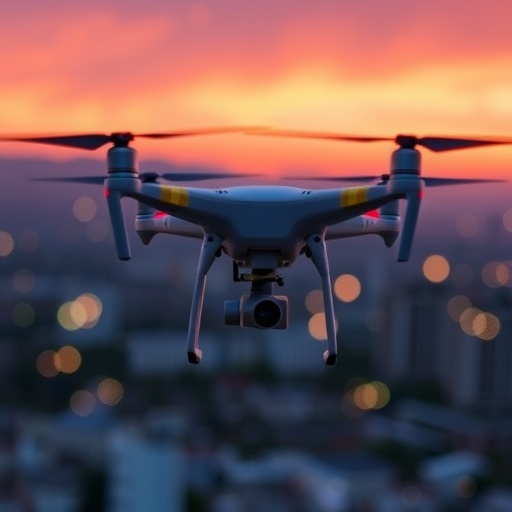The evolution of autonomous systems, particularly unmanned aerial vehicles (UAVs), has opened up unprecedented opportunities in various sectors, including aviation. This technological leap, however, brings with it a unique set of challenges related to legal accountability and safety regulations that need to be meticulously addressed. A groundbreaking study conducted by Fadhil, Al-Haddad, and Al-Karkhi delves into these pressing issues, examining the intersection of legal frameworks and artificial intelligence (AI) in UAV fault diagnosis and compliance with aviation safety regulations. The research highlights the necessity of establishing robust legal accountability mechanisms to navigate the complexities of liability that may arise from UAV operations.
As UAV technology becomes more prevalent in commercial applications, understanding the implications of their use is vital. The study points out that UAV systems, designed to operate autonomously, are susceptible to various faults that can compromise their performance and safety. This raises significant questions regarding liability in the event of an accident. Traditional legal frameworks are often inadequate to address these modern challenges, which necessitates a re-examination of existing laws to account for the nuances of AI technologies in aviation.
One of the core aspects of the research is the application of explainable AI (XAI) in the context of UAV fault diagnosis. Explainable AI refers to AI systems that offer transparent and understandable explanations of their decision-making processes. In the aviation industry, where safety is paramount, having AI support that is not only effective but also interpretable is essential. This transparency can enhance trust in UAV technology among regulators, operators, and the public, facilitating smoother integration into the air traffic system.
Moreover, the researchers emphasize the importance of regulatory compliance in maintaining safety standards in UAV operations. Regulations governing aviation are traditionally rooted in human-operated systems. As UAVs begin to dominate the skies, adapting these regulations to fit the unique characteristics of autonomous systems is crucial. The authors argue that legal accountability should be redefined to encompass both the operators and the AI systems that guide UAV actions. This dual accountability is necessary to ensure that all parties involved can be held responsible in the event of a failure.
Fault diagnosis in UAVs becomes a pivotal area of focus in this study. The authors propose that leveraging advanced AI techniques can drastically improve the identification and management of faults in UAV systems. Investing in smart diagnostics powered by AI could revolutionize maintenance protocols, ensuring that UAVs operate at peak performance and reduce the risk of accidents. The research presents a case for adopting AI-enabled diagnostic tools that can predict potential failures before they occur, thus enhancing overall flight safety.
The paper also discusses how UAV technology can be integrated into existing frameworks without jeopardizing safety. By utilizing AI to continuously monitor UAV operations, stakeholders can gather vast amounts of data that contribute to refining both the technology itself and the regulatory standards that govern its use. This data-driven approach can create a cycle of improvement, where each iteration of UAV technology benefits from insights gained through operational data and fault analysis.
Importantly, the authors tackle the ethical dimensions associated with UAV deployment and AI integration. Dilemmas arise when it comes to accountability, particularly when an AI-controlled machine makes a decision that results in harm. Establishing clear legal definitions and accountability measures is crucial to resolving these dilemmas. The study suggests that an interdisciplinary approach, incorporating legal, technological, and ethical perspectives, will be vital in creating a balanced regulatory landscape.
Another significant concern raised by the authors pertains to public perception and acceptance of UAV technology. Trust is a vital component for the widespread adoption of any new technology. The study highlights the role of effective communication among developers, regulators, and the public in building this trust. Demonstrating the safety and reliability of UAVs through strict regulatory compliance and the use of explainable AI can alleviate fears and misconceptions surrounding the technology.
The continuing evolution of UAV technology necessitates ongoing conversations about legal accountability and safety. As innovations emerge, law and technology must adapt in tandem to prevent regulatory lag. The authors call for the aviation industry to actively engage with AI researchers, legal experts, and ethicists to ensure that the regulatory framework is resilient and forward-thinking. This collaboration can lead to the development of comprehensive policies that adequately address the complexities introduced by UAV operations.
Fadhil, Al-Haddad, and Al-Karkhi’s study serves as a timely and critical examination of these multifaceted challenges. Their findings underscore the importance of proactive measures in the regulatory landscape surrounding UAV operations. The research paves the way for future discussions about the intersection of technology and law, ensuring that safety remains at the forefront of UAV deployment.
In conclusion, the integration of UAVs into aviation presents exhilarating possibilities, but it is essential to confront the accompanying regulatory and ethical challenges head-on. By addressing these issues through a multifaceted approach that encompasses legal, technological, and ethical frameworks, stakeholders can build a future where UAVs operate safely and efficiently within the airspace. The potential for enhanced aviation safety and regulatory compliance is immense, provided that we navigate these complexities with foresight and diligence.
Subject of Research: Legal accountability and UAV fault diagnosis explainable AI in aviation safety and regulatory compliance for liability challenges.
Article Title: Legal accountability and UAV fault diagnosis explainable AI in aviation safety and regulatory compliance for liability challenges.
Article References:
Fadhil, T.H., Al-Haddad, L.A. & Al-Karkhi, M.I. Legal accountability and UAV fault diagnosis explainable AI in aviation safety and regulatory compliance for liability challenges. Discov Artif Intell (2025). https://doi.org/10.1007/s44163-025-00690-2
Image Credits: AI Generated
DOI: 10.1007/s44163-025-00690-2
Keywords: UAV, Legal Accountability, Fault Diagnosis, Explainable AI, Aviation Safety, Regulatory Compliance, Liability Challenges.
Tags: artificial intelligence in aviationchallenges of autonomous systemscompliance with aviation safety standardsevolution of unmanned aerial vehiclesexplainable AI in UAV fault diagnosisimplications of commercial UAV uselegal accountability in UAV operationsliability issues in drone accidentsnavigating AI complexities in aviationrobust legal mechanisms for UAV liabilitytraditional legal frameworks for UAVsUAV safety regulations





